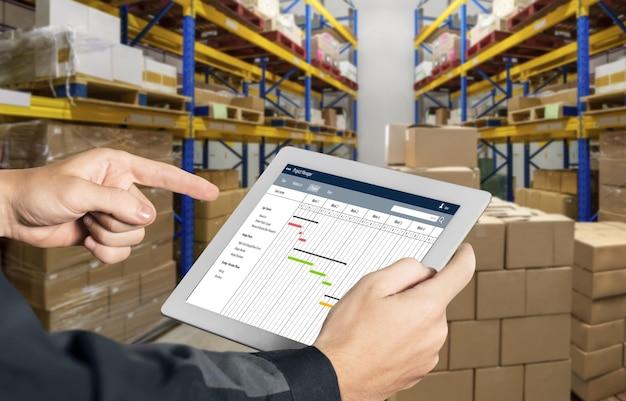Managing inventory in a supermarket can be a daunting task, but it’s essential for running a successful business. From tracking stock to calculating profits, supermarket inventory management is the key to keeping everything organized, streamlined, and profitable.
In this blog post, we’ll delve into the world of supermarket inventory management, discussing various aspects like how to maintain supermarket accounts, what software to use for stock management, and how to keep track of grocery inventory. We’ll also look into inventory management for small grocery stores and explore how it can be scaled up for large supermarkets.
We’ll discuss the benefits of having a good supermarket inventory management system in place and how it impacts the bottom line. We’ll provide a detailed guide on how to implement the best inventory management practices to streamline your supermarket’s operations, optimize your stock levels, and reduce waste and spoilage.
So, whether you’re a small local grocer or a large supermarket chain, this comprehensive guide will equip you with the knowledge and tools necessary to effectively manage your inventory and grow your business. Are you ready to take your supermarket to the next level? Let’s dive right in!
Supermarket Inventory Management: Strategies and Tips
In every successful supermarket, proper inventory management is crucial to keeping customers satisfied and ensuring optimal profits. But managing inventory is not always an easy task, especially when dealing with high-volume sales and perishable items.
Prioritize Stock Optimization
One of the key strategies for effective supermarket inventory management is optimization. This involves determining the right levels of stock to ensure maximum profit while minimizing waste. As a supermarket owner or manager, you must find the perfect balance between keeping enough stock to meet customer demands and avoiding excess stock that could lead to spoilage.
Start by analyzing the sales data for each product to identify any seasonal or fluctuating patterns in demand. Use this data to adjust the inventory management plan accordingly. You should also prioritize tracking the stock levels of fast-moving items to avoid stockouts.
Keep Track of Expiry Dates
Keeping track of expiry dates is a critical aspect of supermarket inventory management. This is especially important for perishable goods that require careful handling and storage. As such, monitoring expiration dates helps to minimize waste and ensure customers get fresh products.
Create a detailed inventory management system that tracks expiration dates, and use first-in, first-out (FIFO) to ensure all stock is used before expiry. This also involves organizing stock in a way that allows you to easily identify products that are about to expire to take necessary action.
Leverage Technology
Managing supermarket inventory manually can be time-consuming and error-prone. With the advent of new technologies, however, owners and managers can streamline inventory management, save time, and reduce errors.
Invest in supermarket inventory management software that integrates with your point of sale (POS) system. This will provide real-time data on inventory levels and sales, ensuring you can make informed decisions about stock management. Technology can also be used to automate ordering and restocking processes to avoid stockouts.
Conduct Periodic Audits
Even with the most efficient inventory management system, there is always room for human error. To minimize this risk, it’s important to conduct regular stock audits. This involves physically counting the items on the shelves and comparing them to the stock levels in the system.
Stock audits will help identify discrepancies and areas where theft or spoilage is occurring, allowing you to take corrective action. Conduct audits at least once a month to ensure the inventory management system is accurate.
Wrapping Up
Managing supermarket inventory is crucial for the success of any supermarket business. By prioritizing stock optimization, keeping track of expiration dates, leveraging technology, and conducting periodic audits, you can ensure optimal inventory management and maximize profits. With these tips, you can streamline your inventory management process and keep your customers satisfied.
How to Maintain Supermarket Accounts
When it comes to maintaining a supermarket’s accounts, it’s not just about recording transactions and balancing the books. It’s also essential to keep accurate records, reconcile bank statements, and minimize errors. Here are some tips on how to maintain supermarket accounts.
Keep Accurate Records
Accurate record-keeping is the backbone of maintaining supermarket accounts. Records should be detailed, including all transactions such as sales, purchases, and refunds.
These records must be updated regularly and organized correctly to avoid missing transactions or miscalculating balances. It is important to double-check all data and reconcile the balance sheet regularly to discover any mistakes or discrepancies.
Reconcile Bank Statements
Reconciling bank statements is critical in maintaining supermarket accounts. It involves comparing the transactions recorded in the company’s books to the transactions recorded in the bank statement.
Reconciling helps to detect errors, including duplications, omissions, and unauthorized charges. When reconciling, ensure that all transactions are accounted for and any discrepancies are resolved.
Minimize Errors
Errors in record-keeping can lead to financial losses and other problems. It is critical to minimize these errors by implementing effective accounting processes, including verifying data regularly, cross-checking all numbers, and double-checking entries before recording them.
Adopting best practices such as ensuring that only trained staff handle accounting functions, using reliable accounting software, and maintaining effective internal controls can help minimize errors.
Maintaining a supermarket’s accounts can be challenging, but with the right practices, it can be easily managed. Accurate record-keeping, reconciling bank statements, and minimizing errors can help supermarket owners keep their financial books in check. By implementing these tips, supermarkets can enjoy financial stability while avoiding potential problems caused by poor account management.
Supermarket Stock Management Software
Managing inventory in a supermarket can be a daunting task. Fortunately, supermarkets can use stock management software to automate the process. This subsection will focus on the benefits of using stock management software in a supermarket.
Streamline the Inventory Management Process
Supermarkets can use stock management software to track inventory levels and automatically reorder products when stock levels fall below a specific level. This reduces the risk of stockouts and overstocking, allowing supermarkets to optimize their inventory levels and save money.
Saves Time and Money
Using stock management software can help save supermarkets time and money. Automation of the inventory management process means less time spent manually checking inventory levels and ordering products. It also ensures that supermarkets achieve optimal stock levels, preventing the loss of money due to overstocking or stockouts.
Provides Accurate Inventory Data
Stock management software provides accurate inventory data in real-time. This data can help supermarkets identify sales trends, fast-selling products, and slow-moving products. This information can help supermarkets make informed decisions about what products to reorder or discontinue.
Makes the Reordering Process Easier
Supermarket stock management software makes the reordering process easy. The software can automatically generate purchase orders based on inventory levels, saving time and reducing the risk of errors. The software can also track deliveries and update inventory levels automatically, reducing the need for manual data entry.
Enhances Customer Experience
Using stock management software can enhance the customer experience by ensuring that popular products are always in stock. It also reduces the risk of stockouts, ensuring that customers can always find what they’re looking for. This can lead to increased customer satisfaction and repeat purchases.
In conclusion, using stock management software is a wise investment for supermarkets looking to optimize their inventory management processes. It saves time and money, provides accurate inventory data, makes reordering easier, and enhances the customer experience.
Inventory Management in Supermarkets PDF
Inventory management is essential in any retail business, especially in the supermarket industry. Efficient inventory management can help supermarket owners reduce costs, increase profits, and enhance customer satisfaction. In this subsection, we’ll discuss inventory management in supermarkets PDF.
What is Inventory Management in Supermarkets PDF
Inventory management in supermarkets PDF is the process of tracking and controlling all stock items in a supermarket using a digital or physical document. This document helps supermarket owners to keep track of the number of goods they have in stock and to determine when to reorder more items. The PDF document can contain information such as item name, quantity, description, supplier, and price.
Benefits of Inventory Management in Supermarkets PDF
Proper inventory management in supermarkets PDF offers a range of benefits, including:
Enhanced Stock Control
Inventory management in supermarkets PDF provides accurate and real-time updates on the number of goods available in stock. Supermarket owners can use the PDF document to monitor stock levels and reorder items when the stock falls below a certain threshold level, avoiding stockouts and oversupply.
Efficient Use of Resources
Implementing inventory management in supermarkets PDF eliminates manual tracking and recording of stock levels, saving supermarket owners time and reducing the likelihood of errors. With real-time updates, supermarket owners can make informed decisions about inventory control, reducing waste and reducing inventory carrying costs.
Improved Customer Satisfaction
Inventory management in supermarkets PDF ensures that popular products are always in stock when customers need them, enhancing customer satisfaction and loyalty. Supermarket owners can also use the PDF document to track product performance and remove items that are not selling well.
Inventory management in supermarkets PDF is an essential aspect of any supermarket business. The benefits of implementing inventory management in supermarkets PDF include enhanced stock control, efficient use of resources, and improved customer satisfaction. By using a digital or physical document to track stock items, supermarket owners can reduce costs, increase profits, and enhance overall business performance.
How Inventory is Managed in a Supermarket
In managing inventory in a supermarket, there are several methods to ensure that the goods are kept in stock, orders are placed at the right time, and the shelves have enough stock to keep customers coming and buying. Here are some of the ways that supermarkets keep their inventory organized:
Regular Stocktaking and Analyzing Sales Data
Supermarkets must regularly conduct stocktaking to see the available stock and the products that are selling and the ones that are not. The store managers will then analyze the sales data to know which products are selling out fast and which ones they should reduce the orders. With this analysis, they can identify trends in consumer behavior related to buying, which enables them to stock up on the fast sellers and avoid losses on the slow movers.
Adopting Inventory Management Software
Supermarkets have computer-based systems that help them to keep track of their inventory. They use the Point of Sale (POS) system, which enables them to track inventory levels and get alerts on when it is time to place orders. The system also allows them to automate the ordering process, which saves time and minimizes errors.
Proactive Supplier Management
Supermarkets have multiple suppliers to ensure that they have a variety of products available for customers. They form a strategic partnership with their suppliers who provide them with regular updates on product availability, pricing, and delivery schedules.
Using Just-In-Time (JIT) Inventory System
JIT is a popular inventory management system in which supermarkets hold minimal inventory and only reorder stock when it is required. This approach ensures that the store does not incur any losses from stock that does not sell out. The downside is that it requires a sophisticated inventory tracking system that can predict when products will run out and schedule the next order.
Supermarkets have many options when it comes to managing their inventory. However, the effectiveness of each method relies on their analysis of sales, planning, and partnership with suppliers. Through regular stocktaking, inventory tracking software, strategic supplier management, and JIT inventory management, supermarkets can ensure that they have the right products available at the right time to meet customers’ needs.
How Do You Keep Track of Grocery Inventory
Managing inventory for a supermarket can be a daunting task, especially when stock tracking is done manually. It is important to keep track of what products are selling and what products are not. Here are some tips on how to keep track of grocery inventory:
Utilize Inventory Management Software
Inventory management software is designed to handle the complex tasks of managing your inventory. These software tools can track inventory levels, set reorder points, and create purchase orders automatically. When inventory levels fall below a certain point, the system will alert you to order more.
Use Barcode Scanners
Barcodes are everywhere, and for good reason. They make tracking inventory a breeze. With barcode scanners, you can easily scan items as they arrive and leave the store. The system will automatically adjust the stock levels to reflect the changes, which helps keep track of your grocery inventory with ease.
Conduct Regular Audits
Regularly auditing your inventory can help to identify discrepancies and prevent any theft or loss. Conducting audits at regular intervals, such as once per month, can help to identify any issues before they become a problem. During an audit, verify that everything is accounted for on the inventory list.
Train Employees Properly
Train your employees on how to utilize inventory management software or other tracking systems. Proper training ensures that everyone is using the system correctly, and it helps to keep track of inventory levels accurately.
Keep Stock Organized
Keeping your stock organized will not only make your store look cleaner but will help you keep track of what products are running low or out of stock. Having an organized stock makes the stocktaking process easier.
Keeping track of grocery inventory might appear to be a daunting task, but with the right tools and mindset, it can be done easily and efficiently. While the methods outlined in this subsection are just a few ways to manage stock, you can also adopt custom methods that work best for your supermarket. The most important thing is to be consistent, accurate, and to utilize the latest technology to make the process much more manageable.
Inventory Management for Small Grocery Stores
When it comes to inventory management, big supermarkets have an advantage over small grocery stores due to the availability of resources. However, inventory management for small grocery stores is equally important. It ensures that small grocery stores increase their sales while minimizing stock loss due to wastage or stockouts.
Track Your Stock Levels Regularly
Small grocery stores have to manage their inventory efficiently to avoid overstocking or understocking. The best way to do this is to track stock levels regularly. You can use a spreadsheet to track your inventory, add a column for the product name, description, SKU, supplier information, quantity, and other relevant details.
Set a Minimum and Maximum Stock Level
To ensure efficient inventory management, set a minimum and maximum stock level for each product. A minimum stock level is the point at which you need to order more products to avoid stockouts. The maximum stock level is the point at which you have enough products, and ordering more would lead to overstocking.
Categorize Your Products
Categorizing your products helps in inventory control. For instance, group the products by season, supplier, popularity, or expiry date. This will help you know which products are selling and which ones are not, and it will also help you identify products that need to be removed from your shelves.
Use an Inventory Management System
Implementing inventory management software will help small grocery stores streamline their inventory management. The software automates the inventory tracking process, provides automatic alerts for restocking, and generates reports on sales, stock levels, and wastage.
Inventory management is vital for the success of small grocery stores. Tracking your stock levels, setting a minimum and maximum stock level, categorizing your products, and using an inventory management system ensures efficient inventory management. By implementing inventory management practices, small grocery stores can increase their sales, minimize waste and stockouts, and boost their ROI.
Supermarket Inventory Management System Project Report
In today’s world, supermarket inventory management has become a critical aspect of any retail business. Managing inventory can be overwhelming and time-consuming, especially for large retail businesses. This is where supermarket inventory management system projects come in handy. These systems are designed to help retailers manage their inventory more efficiently and effectively.
What is a Supermarket Inventory Management System
A supermarket inventory management system is a software solution designed to help businesses track their inventory levels, monitor sales performance, and manage orders and deliveries. It includes tools that can automate processes and provide real-time insights to make informed decisions that drive sales and profit.
Why Use a Supermarket Inventory Management System
The reasons for using a supermarket inventory management system are numerous. Firstly, it can help to reduce inventory costs by ensuring that you have just enough stock to meet demand, reducing stockouts and overstocks. Secondly, it streamlines the ordering process, making it easier to keep up-to-date with stock levels and the necessary reordering. Thirdly, it can streamline invoicing and sales reports, providing greater insights into the sales performance of a store. Lastly, it can help retailers make informed decisions about purchases, promotions, and markdowns based on real-time data.
Features of a Supermarket Inventory Management System Project Report
A comprehensive supermarket inventory management system project report should include various features and functionalities that are essential to the success of a retail business. These features include:
- Inventory tracking: The ability to track inventory levels across multiple stores and locations.
- Barcode scanning: This feature helps retailers to track inventory and stock levels more accurately and efficiently.
- Sales monitoring: This feature helps retailers to monitor sales performance and get real-time data to inform business decisions.
- Ordering and purchasing: The system should be able to automate order and purchasing processes, making it easier to manage supplies, order stock, and comply with vendor agreements.
- Reporting: It should provide detailed reports on inventory levels, sales, profits, and other essential data.
In conclusion, a supermarket inventory management system project is essential for any retail business that wants to optimize its inventory management, streamline operations, and drive sales and profitability. It provides real-time insights that help businesses make informed decisions and stay ahead of the competition. By implementing a supermarket inventory management system, you can look forward to efficient and organized inventory management, streamlined processes, and improved profitability.
What is the Best Supermarket Inventory Management Software
Managing inventory for a supermarket can be a handful, especially for big supermarkets with a high volume of products sold daily. To streamline the inventory management process, supermarket owners and managers turn to inventory management software. But with so many options available, it can be difficult to determine the best one for your supermarket. Here are some things to consider:
Features to Look for
When selecting supermarket inventory management software, look for one that has the following features:
- Real-time inventory tracking
- Barcode scanning
- Sales forecasting
- Automatic ordering and restocking
- Batch tracking
These features let you keep track of your inventory and reduce the odds of overstocking or running out of items.
What to Avoid
There are also some things to avoid when selecting supermarket inventory management software. You want to avoid software with:
- Poor reviews
- Limited functionality
- Complicated user interfaces
- Compatibility issues
These issues can make the software frustrating and ultimately not worth the purchase.
Top Supermarket Inventory Management Software
When it comes to selecting the best supermarket inventory management software, there are a lot of options in the marketplace. Some of the most popular ones include:
- QuickBooks POS
- Square for Retail
- ShopKeep
- Vend
- Lightspeed
Each has its own unique features and pricing structures. It’s important to compare these options and review your specific needs to determine which software is the best fit for your supermarket.
Supermarket inventory management software is a must-have for any supermarket looking to streamline its inventory management process. To determine the best one to purchase, look for key features, avoid software with poor reviews or limited functionality, and compare options in the marketplace. With the right software, you can keep track of your inventory with ease, reduce waste, and ultimately increase your profitability.



